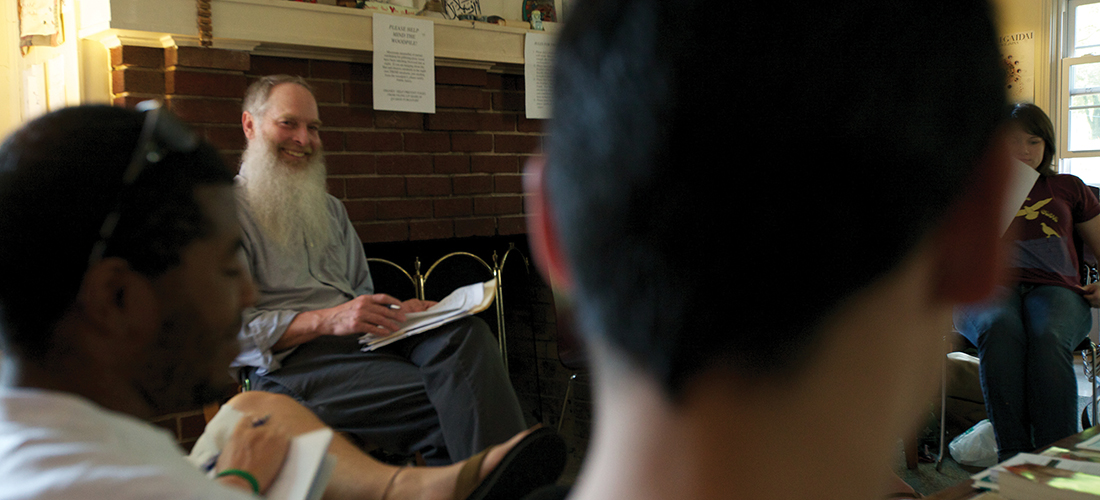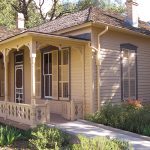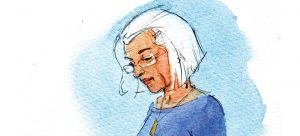
Gate City Journal
A walk through the mists of time with historian Max Carter
By Billy Ingram
Sometime around the year 1806, a young boy waited patiently alongside a dirt roadway near what is now New Garden Road as winding coffles of slaves being transported to marketplace passed by. He asked his father why those dark-skinned men and women were bound in chains; his father’s explanation horrified young Levi Coffin. Since the 1770s, the Religious Society of Friends, Quakers like himself, had almost entirely divorced themselves from the institution of slavery. This pernicious notion festered in Levi Coffin’s consciousness. Ultimately it led to one of history’s most remarkable achievements, one that would bend the arc of social justice and forever reshape our nation.
Trolling through the wooded area now known as New Garden searching for farrowing sows, young Levi would, on occasion, encounter frightened slaves escaping. Fetching cornbread and bacon for the fugitives, he would sit in rapt attention as they told harrowing tales of the brutal conditions and inhuman treatment they suffered on plantations to the east.
It was not long after his 15th birthday, while attending a late-October community corn husking, that Levi Coffin took notice of a band of slaves that labored under the whip of a prominent trafficker. As white folks answered the dinner bell, congregating around tables inside the farmhouse, likely no one noticed Levi as he slipped away to join the enslaved individuals in order to, in his words, “See if I could render them any service.” It was there he met Stephen, a freeborn African American who had, years earlier, been kidnapped from the home of Philadelphia Quaker Edward Lloyd before being sold to the highest bidder as common chattel. Outraged, Levi wrote to Lloyd to assess him of the situation. After concerted effort, Stephen made the journey back to his rightful home.
Tortured souls seeking a better life began following a lightly worn pathway into the New Garden woods to a particular tulip poplar tree that offered concealment from bloodhounds and bounty hunters, with food hidden nearby by sympathetic Quakers. There Levi and his cousin Vestal could direct these men and women toward sympathetic outposts along the various routes away from the state, farmers that could provide temporary shelter and nourishment.
In 1821, under the guise of furthering Christianity and spreading the wonders of the Bible to the heathens, the Coffin cousins organized a Sunday School class to teach slaves to read and write. After all, one could hardly make the case that slaves shouldn’t be taught the scripture. This was a short-lived effort, the school was forcibly shuttered when prominent slave owners wised up to the two men’s real intent. It was a deeply held moral opposition to the ingrained culture of slavery that fueled a mass migration of 20,000 Quakers from the South to Indiana, including the Coffin family.
Which brings us to the present. . .
This Hallows Eve may have you considering an experience among the pines where zombies and ghouls (or those made-up to appear as such anyway) startle terrified ticket holders. Or perhaps a Halloween haunted house at a local church featuring icky abortion mishaps or the grotesque aftereffects of a gruesome drunken automobile accident.
More satisfying, by far, would be to spend the evening by lantern light in a graveyard whose inhabitants have lain peacefully since before the city of Greensborough was founded, their eternal slumber having begun decades prior to Nathanael Greene confronting overwhelmingly superior British forces on these grounds in 1781, sending the enemy into retreat.
About fifteen years ago Max Carter, retired director of the Friends Center at Guilford College, began an annual Halloween New Garden Friends Cemetery tour. Posing as a white-bearded Gandalf holding aloft the old lantern his father once used to light dairy barns in Indiana, Max leads a merry band of historical thrill seekers from stone to stone, ricocheting across the corridors of time with the help of costumed players portraying many of the luminaries buried there. As to the ancient burial ground’s origin, Carter explains, “Henry Ballinger and Thomas Hunt bought 53 acres in 1757 from Richard Williams for the use of New Garden Friends Meeting for a cemetery and meetinghouse. Richard Williams had a farm where Western Guilford High is now. Guilford College is built on the Williams farm as well. Richard Williams then later contracted smallpox tending to soldiers during the Revolutionary War and died. He’s buried in the cemetery.”
As you meander through yesterdays you’ll develop a greater understanding of the threads that weave in and out of our shared history, the backstories behind familiar names that grace our street signs and longtime local businesses: Addison Boren, whose sons turned mud into millions with their terra cotta pipes and bricks; John Van Lindley’s Pomona Hills Nursery, who introduced peaches to the area before he founded an insurance company that ultimately became Jefferson Standard Life; Mary Mendenhall Hobbs, who advocated for female education in the late 1880s, leading to the first public college for women, now known as UNCG.
You’ll meet other fascinating and deceased individuals who shaped and molded our community such as John and Mary Woody, who parceled off a significant portion of their land for African Americans to purchase after the Civil War. From his inheritance, their son Waldo donated more land for a nearby school to be built, thereby establishing the Woodyside neighborhood where Hedgecock Lumber was a neighborhood institution near the intersection of West Market and College Road, birthplace of blues musician Lorenzo “Logie” Meachum.
The ball-playing Ferrell brothers are also buried here. One of those seven boys, Rick Ferrell, was inducted into the Baseball Hall of Fame with the American League record for most games caught, a milestone that went unmatched for over forty years. Back in the 1920s, as Max Carter tells it, “The brothers lived on a dairy farm on West Market where Hidden Lakes is now. Sundays you didn’t work, you milked the cows; that’s it. So they played baseball. Two of them went professional, Wes Ferrell was one of the greatest pitchers of the ’20s and ’30s.”
There are points along the way when Max will tell a story that leaves the audience gasping; then he drops the mic to quickly move on to another amazing tale. For instance: Clyde Milner, Guilford’s longest serving president Milner assisted the American Friends Service Committee when they freed Japanese-American college students from internment camps during Word War II by transporting them east to receive an education. That international Quaker peace and justice organization also successfully negotiated terms that allowed German Jews to avoid concentration camps just before WWII broke out to resettle in Greensboro. It was also under Milner’s administration that the college was integrated in 1962. Among others those who emigrated in 1939 were Curt and Gertrude Victorius. Curt Victorius was chief economist of the German National Banking Association.
Wear your walking shoes; you won’t just cover a lot of ground, you’ll cover a lot of territory. Not far from a mass grave containing 150 British and American soldiers, you’ll gather beside a marker commemorating the Revolutionary Oak that was the victim of a terrorist attack in 1955. Max Carter elaborates, “Quakers were working to help Greensboro integrate the public schools after Brown vs. Board of Education. Surprise, surprise! The local school board was not anxious to do that here. The American Friends Service Committee sent trainers down here to work with the local black and white populations, to ramp up integration but to do it creatively and nonviolently. They invited
Eleanor Roosevelt to come down and address an integrated audience, of blacks and whites sitting together in the meeting house at what is now New Garden Hall at the college. While she was addressing them, talking all about civil rights and integration, three locals who weren’t overly enthusiastic about her coming stuck dynamite at the base of the oak tree in the cemetery and blew it up as a protest.
“It had been there during Revolutionary battles and shaded fallen soldiers. It had become kind of an icon in the community,” Carter says. “It was so massive it didn’t come down immediately. It came down in a storm four years later. When they counted the rings they said it was born in 1492.” There are remnants of that tree all over the community. People made tables, chairs and offering plates out of it. “Just a couple of months ago an old gentleman in Alamance County passed away, but before he died he invited a bunch of us out to see what he wanted to give the college,” Carter continues. “Behind his hen house were planks of sawed lumber from that tree. So there are woodworkers at the college right now turning the last remnants of the Revolutionary Oak into furniture.”
Remember Levi Coffin, earlier in this story? Halloween-nighters will encounter his family’s final resting place, as well. That story, remarkable as it is, didn’t end with an aborted but significant attempt to educate local blacks. Over time, with so many African descendants being driven into the New Garden woods from far away counties and states, Levi and his cousin Vestal developed an intricate network of safe houses to shelter runaways as they made their way north or west. The woods at the perimeter of New Garden Cemetery became the initial spur for what became the Underground Railroad in 1819. The tulip poplar that served as a waiting room for fugitives from injustice fleeing North Carolina over 150 years ago still flourishes today. It’s the second largest in the state.
“One of the last graves we stop at is Vestal Coffin, he was the First Conductor on the Underground Railroad. He died on his 34th birthday before he could make it out to Indiana,” Carter says. “He left a young widow, his wife Alethea, who had, I think, four kids. She was in her 20s and had a 170-acre farm, where Jefferson Standard Country Club was and she didn’t want to leave the side of her husband. So she continued to farm until her kids were grown up.” The offspring all made the trek as part of a mass exodus out of the state to Indiana but kept begging their mother to join them. She finally acquiesced in the late-1830s, packed up a wagon and headed northwest, “But the wagon was so bumpy she got out and walked the whole way,” Carter goes on. “She stayed there a few months, couldn’t stand being away from what where she and her husband had made their home, so she came back and was matron of the women’s side of the old boarding school for several years until in her old age. She finally went back up to Indiana to live with her family but with the condition that when she died she’d be returned to be buried next to her husband.” Carter pauses before concluding. “She died in 1891, 65 years a widow, and on her epitaph it says, “Died in Indiana, buried in her wedding dress.” The women in the group always say, “Well, if you’re walking back and forth to Indiana you’ll fit in that dress.”
After the first few Halloween tours Max Carter wondered if it might have a broader appeal, “I decided to advertise it a little bit, see if anyone outside the Guilford, New Garden Quaker community would be interested and seventy-five people showed up,” he recalls. “They didn’t have a clue; that was the thing that amazed me. People aren’t aware of that history. And they started talking to their friends about it and it started expanding so we do an alternative Memorial Day tour highlighting those who died in service of their country — traditionally, but also those who risked their lives in service of their country nonviolently. Then we do a Fourth of July tour that focuses not only on the struggle for independence, the Battle of New Garden, Guilford Courthouse were all fought out here, but also the Underground Railroad, civil rights, and other Quaker peace work.”
In a resting place this old, especially on Halloween night, you could just bet there’ll be restless spirits, pranking poltergeists, ghostly apparitions that have perplexed and frightened cemetery-goers for generations. In this instance . . . not so much. Max Carter tells folks, “While we’re traipsing through the cemetery, you don’t have to be worried if you step on graves because Quakers are as benign in death as they are in life. The only ghost stories that we know of are the three restless spirits on the Guilford College campus.” One of them is one of the Revolutionary war soldiers “Lucas is his name. He haunts Dana Auditorium. The other haunts Mary Hobbs Hall. Nobody knows anything about her. She’s a young girl, she moves furniture and opens drawers, locks people out of their room if they’ve been ‘naughty girls’ and snuck out after curfew. The third one is up in Founder’s Hall, the ghost of a college nurse who committed suicide in her apartment.”
The October 31st lantern-lit walking tour of New Garden Cemetery begins promptly at 8 p.m. I won’t just be there in spirit, I’ll be playing the role of preacher Vance Abner who was known for witticisms such as: “Most American Christian worship starts at 11sharp on Sundays and ends at 12 dull.” Sounds like a swell guy.
Join Max Carter’s celebration of those stoic individuals that laid the foundations and defined the character that made our unsure-footed city great, Quaker activists who saw war and sought peace, recognized injustice and brought about change and who, lo these many generations later, continue to inspire and excite. OH
Billy Ingram always finds it interesting when the subject of an interview declares, “I tell stories, half of ’em are true. You just have to figure out which half.”





